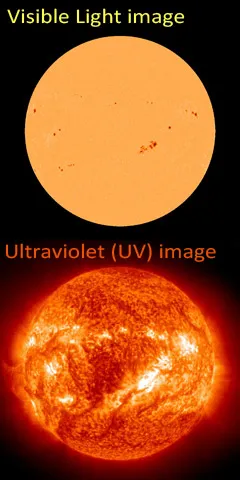Three Years of the Sun
NASA Goddard
The Solar Dynamics Observatory (SDO), a satellite launched by NASA in 2010, carries a telescope for viewing the Sun in incredible detail. This movie shows a time-lapse view of the Sun from SDO spanning the satellite's first three years of operation. The Sun spins around once every 27 days, but in this movie it spins once every few seconds because the movie is sped up a lot.

The Sun as viewed in visible light and ultraviolet wavelengths.
SOHO (ESA & NASA)
The first part of the movie shows the Sun in ultraviolet (UV). UV light comes from hot, high-energy features in the Sun's atmosphere. The bright regions seen on the sun are near active regions that form around sunspots. Sunspots appear in places where the Sun's magnetic field is highly disturbed. The solar magnetic field near a sunspot is often a thousand times stronger than elsewhere on the Sun. Solar flares and coronal mass ejections (CMEs) often erupt from these magnetically disturbed active regions. You can also see glowing coronal loops of superheated plasma arching over the active regions in these UV images.
The latter part of this movie shows the Sun in four different wavelengths of electromagnetic radiation. The top-left view, marked 4500 Ångstroms, is visible light. The other three views show different wavelengths of UV, which are like different colors of light. Each wavelength allows us to see unique aspects of the Sun. The 304 Ångstroms image (lower right) shows features in the Sun's chromosphere. The chromosphere is hotter than the Sun's surface (the photosphere), which is what we see in the visible light image. The other two views - 171 Ångstroms (lower left) and 193 Ångstroms (upper right) - show higher energy UV images of the Sun. They provide a view of the Sun's corona. The corona is even hotter than the chromosphere, with temperatures reaching millions of degrees.
Can you see how the bright areas in the UV images often appear in the same place as sunspots in the visible light image?